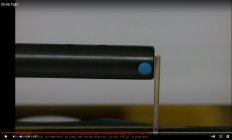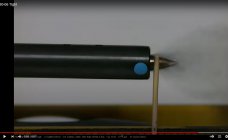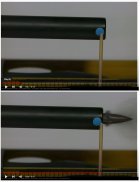You are using an out of date browser. It may not display this or other websites correctly.
You should upgrade or use an alternative browser.
You should upgrade or use an alternative browser.
Does the Rifle Move?
- Thread starter Killick
- Start date
Cool video, but we haven't learned anything we didn't know.
Now, get that camera, a Ransom rest, and a 1911, and somebody gonna learn sumthin' 'bout 1911 slide delay. . . that's a fun debate to watch!
Now, get that camera, a Ransom rest, and a 1911, and somebody gonna learn sumthin' 'bout 1911 slide delay. . . that's a fun debate to watch!
lazyMlazyK
Silver $$ Contributor
What's all that extra "stuff" coming out after the bullet exits?
Gargoyle
Finder Outer
I don't know how to process this. I was always told the barrel was oscillating in a cone shape and the bullet exits at some point in that oscillation and getting the bullet to exit at the same point in oscillation is harmonics. It's like finding out Santa isn't real...For those who are just learning about this, notice "barrel whip" involved . . . like none while bullet is still in the bore.
View attachment 1326685
View attachment 1326686
Unburnt powder.What's all that extra "stuff" coming out after the bullet exits?
Oh, it oscillates all right and that harmonic vibration travels down the barrel faster than the bullet, but the movement is very small, yet enough to make a difference in POI, especially at distance. It's just that it's not the same as "barrel whip".I don't know how to process this. I was always told the barrel was oscillating in a cone shape and the bullet exits at some point in that oscillation and getting the bullet to exit at the same point in oscillation is harmonics. It's like finding out Santa isn't real...
Last edited:
I disagree that there's data to support that. Barrel whip is far too small (in thousandth$) to observe in that video.For those who are just learning about this, notice "barrel whip" involved . . . like none while bullet is still in the bore.
Last edited:
If there is a point to this, I'm not sure what it is. If you've ever used a tuner, the results downright prove that your perception of no movement is wrong...Or else, they would do nothing to group shape and size. As others have already stated, the movement is small and at about 18,000-20,000fps in steel. Even without a tuner, your video, if it was of any value in this context, would certainly raise questions as to how tuning with powder and/or seating depth can affect group shape and size. If the barrel didn't move, groups would all be a straight vertical line based on velocity alone. (minus wind of course)Pretty straightforward...er, backwards.
That's simply not the case, as we all know.
Deleted Dewey
Clearly, you've not "outsourced" your cognitive abilities to Youtube, Google and Facebook, like so many others have.If there is a point to this, I'm not sure what it is. If you've ever used a tuner, the results downright prove that your perception of no movement is wrong...Or else, they would do nothing to group shape and size. As others have already stated, the movement is small and at about 18,000-20,000fps in steel. Even without a tuner, your video, if it was of any value in this context, would certainly raise questions as to how tuning with powder and/or seating depth can affect group shape and size. If the barrel didn't move, groups would all be a straight vertical line based on velocity alone. (minus wind of course)
That's simply not the case, as we all know.
Warren Dean
Team Savage F-TR
Well put.Clearly, you've not "outsourced" your cognitive abilities to Youtube, Google and Facebook, like so many others have.
Dave M.
F-Open Class shooter (284 win, 6dasher, 6.5-7PRCW)
Speed of sound in stainless steel is over three times faster than the speed of the bullet. Speed of sound in steel is over 10,500 fps. This is the “speed” of the sine wave like oscillations a barrel experiences.Oh, it oscillates all right and that harmonic vibration travels down the barrel faster than the bullet, but the movement is very small, yet enough to make a difference in POI, especially at distance. It's just that it's not the same as "barrel whip".
dave
jackieschmidt
Gold $$ Contributor
Interesting.
I’m not sure what the bullet velocity is, but wouldn’t it be reasonable to assume that if that bullet was moving at 2900 fps, and the barrel only over about 1/16 inch before it cleared the muzzle, would a bullet moving 3400 fps have already cleared the muzzle before the actual movement under recoil?
I’m not sure what the bullet velocity is, but wouldn’t it be reasonable to assume that if that bullet was moving at 2900 fps, and the barrel only over about 1/16 inch before it cleared the muzzle, would a bullet moving 3400 fps have already cleared the muzzle before the actual movement under recoil?
There is no "before" the movement of the gun, unless you're referring to "before" the movement of the bullet. The bullet moves forward, and the gun moves backward, and both begin at the same time driven but the same force.. . .would a bullet moving 3400 fps have already cleared the muzzle before the actual movement under recoil?
That the gun moves much slower does not mean it starts later.
Alexander-M
Gold $$ Contributor
CharlieNC
Gold $$ Contributor
Vaughn and Kolbe instrumented barrels and found similar results. Regular cartridges have barrel times around 1.25 +/- milliseconds vs barrel vibration in the range of 10000+/- cycles per second with an amplitude of a few thousands inch at the muzzle which are utilized for tuning. This is in addition to the "low" frequency behavior typically reported and shown as "whip" long after the bullet exits. Chris Long's calculations were the most representative, with perhaps a misrepresentative mechanism .
Did the barrel actually move forward a bit, before it started moving backward?
The backward movement does not appear to be shooter induced, it looks smooth, but then again it is high speed in very slow motion, and in a rest.
But the small forward movement, if I’m actually seeing that right, I wouldn’t expect to see from recoil. I only watched the one short clip muted, so if the shot was narrated and didn’t involve a shoulder, I’m not aware.
The backward movement does not appear to be shooter induced, it looks smooth, but then again it is high speed in very slow motion, and in a rest.
But the small forward movement, if I’m actually seeing that right, I wouldn’t expect to see from recoil. I only watched the one short clip muted, so if the shot was narrated and didn’t involve a shoulder, I’m not aware.
I think his theory only represents one aspect of barrel movement. A common thing using his calculations is that most say they get you "close." Using a tuner, it's very clear that there are multiple sweet spots and they are relatively "close" together also. What I'm trying to say is that tune just repeats over and over again. The distance is based on the natural frequency of the barrel. With a tuner, we are slightly manipulating the frequency but more accurately, we are altering phase time. Essentially, this just means that we are shifting the top of the sine wave left or right to coincide with bullet exit. I'll post a pic in a minute. Don't read too much into the actual groups at this point but check out the very clear sine wave pattern on the target. This is a 100 yard test target. I'm not posting it to show that the groups are perfect or not, but that the sine wave is very apparent.Vaughn and Kolbe instrumented barrels and found similar results. Regular cartridges have barrel times around 1.25 +/- milliseconds vs barrel vibration in the range of 10000+/- cycles per second with an amplitude of a few thousands inch at the muzzle which are utilized for tuning. This is in addition to the "low" frequency behavior typically reported and shown as "whip" long after the bullet exits. Chris Long's calculations were the most representative, with perhaps a misrepresentative mechanism .

CharlieNC
Gold $$ Contributor
I think his theory only represents one aspect of barrel movement. A common thing using his calculations is that most say they get you "close." Using a tuner, it's very clear that there are multiple sweet spots and they are relatively "close" together also. What I'm trying to say is that tune just repeats over and over again. The distance is based on the natural frequency of the barrel. With a tuner, we are slightly manipulating the frequency but more accurately, we are altering phase time. Essentially, this just means that we are shifting the top of the sine wave left or right to coincide with bullet exit. I'll post a pic in a minute. Don't read too much into the actual groups at this point but check out the very clear sine wave pattern on the target.
View attachment 1326946
Exactly! The sine wave achieved by varying charge weights agrees with Long's optimum barrel time, whereas he only considers muzzle diameter swell. Kolbe's results also exhibit phase shift dominates frequency using a tuner. I need to write up my method to determine the barrel vibration frequency from a charge weight ladder.
Similar threads
- Replies
- 22
- Views
- 1,380
Upgrades & Donations
This Forum's expenses are primarily paid by member contributions. You can upgrade your Forum membership in seconds. Gold and Silver members get unlimited FREE classifieds for one year. Gold members can upload custom avatars.

Click Upgrade Membership Button ABOVE to get Gold or Silver Status.
You can also donate any amount, large or small, with the button below. Include your Forum Name in the PayPal Notes field.
To DONATE by CHECK, or make a recurring donation, CLICK HERE to learn how.

Click Upgrade Membership Button ABOVE to get Gold or Silver Status.
You can also donate any amount, large or small, with the button below. Include your Forum Name in the PayPal Notes field.
To DONATE by CHECK, or make a recurring donation, CLICK HERE to learn how.












